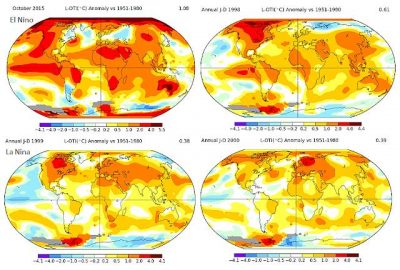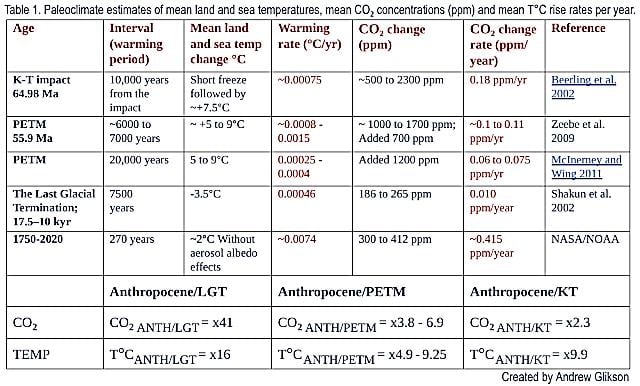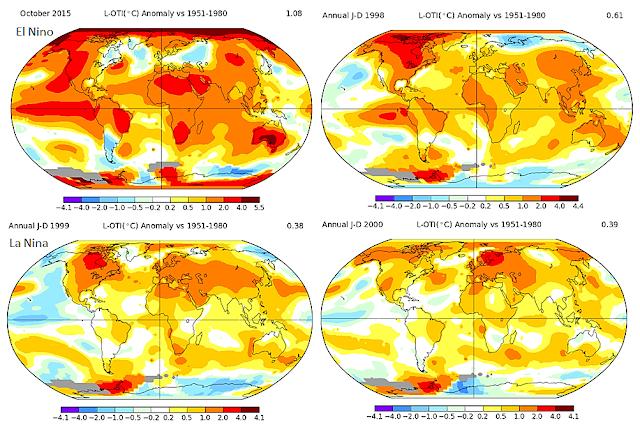Climate Change: The Fatal Road to 4 Degrees Celsius
Extreme GHG and T°C rise rates exceed climate tipping thresholds

Global CO₂ rise and warming rates have reached a large factor to an order of magnitude higher than those of the past geological and mass extinction events, with major implications for the shift in climate zones and the nature and speed of current extreme weather events. Given the abrupt change in state of the atmosphere-ocean-cryosphere-land system, accelerating since the mid-20ᵗʰ century, the terms climate change and global warming no longer reflect the nature of the climate extremes consequent on this shift. Further to NASA’s reported mean land-ocean temperature rise to +1.18°C for March 2020, relative to the 1951-1980 baseline, large parts of the continents, including Siberia, central Asia, Canada, parts of west Africa, eastern South America and Australia are warming toward mean temperatures of +2°C and higher.
The rate exceeds that of the Last Glacial Termination (LGT) (21–8 kyr), the Paleocene-Eocene hyperthermal event (PETM) (55.9 Ma) and the Cretaceous-Tertiary boundary (K-T) (64.98 Ma) impact event. A principal question arises regarding the relationships between the warming rate and the nature and progression of the current migration climate zones toward the poles, including changes in the atmosphere and ocean current systems. Significant transient cooling pauses, or stadials, are projected as a consequence of the flow of cold ice melt water from Greenland and Antarctica into the oceans.

Figure 1. Global temperature distribution in March 2020, relative to a 1951-1980 baseline. NASA GISS.
The K-T impact and subsequent warming
According to Beerling et al. (2002) the CO₂ change triggered by the K-T impact event 65 Ma years ago involved a rise from about 400-500 ppm to 2300 ppm over 10.000 years from the impact (Fig. 2) at a rate of 0.18 ppm/year. This is less than the mean Anthropocene CO₂ rise rate of 0.415 ppm/year and an order of magnitude less than the 2 to 3 ppm/year rise rate in the 21ˢᵗ century. Likewise the Anthropocene temperature rise rate of ~ 0.0074°C/year is high by an order of magnitude as compared to the K-T impact event rate of~ 0.00075°C/year (Table 1) reported by Beerling et al. (2002).
Beerling et al.’s (2002) estimate, based on fossil fern proxies, implies an initial injection of at least 6,400 GtCO₂ and possibly as high as 13,000 GtCO₂ into the atmosphere, significantly higher than values derived by Pope et al. (1997). This would increase climate forcing by +12 Wm⁻² and mean warming of ~7.5°C, which would have strongly stressed ecosystems already affected by cold temperatures and the blockage of sunlight during the impact winter and associated mass extinction at the KT boundary (O’Keefe et al. 1989).

Figure 2. Reconstructed atmospheric CO₂ variations during the Late Cretaceous–Early Tertiary derived from the SI (Stomata index) of fossil leaf cuticles calibrated by using inverse regression and stomatal ratios. Beerling et al. (2002).
The PETM hyperthermal event
The Palaeocene–Eocene Thermal Maximum, about 55.9 Ma, triggered the release of a large mass of light ¹³C-depleted carbon suggestive of an organic source, likely methane, has led to a global surface temperature rise of 5 – 9°C within a few thousand years (Table 1; Fig. 3). Deep-sea carbonate dissolution indices and stable carbon isotope composition were used to estimate the initial carbon pulse to a magnitude of 3,000 PgC or less. As a result, atmospheric carbon dioxide concentrations increased during the main event by up to 70% compared with pre-event levels, leading to a global surface temperatures rose by 5–9°C within a few thousand years.
Figure 3. Simulated atmospheric CO2 at and after the Palaeocene-Eocene boundary (after Zeebe et al. (2009).
The last glacial termination
Paleoclimate indices based on ice cores and isotopic evidence suggest temperature rise generally correlates with CO₂ during the Last Glacial Termination between 17.5 kyr to 10 kyr. Whereas the rise rates of CO₂ and temperature are broadly parallel the temperature somewhat lags behind CO₂ (Figure 2), including changes of CO₂ (186 – 265 ppm) and of temperature (T°C -3.3°C – +0.2°C) (Fig. 4). A rise rate of ~0.010 ppm CO₂/year and of temperature ~0.00046°C/year are indicated (Table 1) (Shakun et al., 2012). Differences between temperature changes of the Northern Hemisphere and Southern Hemisphere correspond to variations in the strength of the Atlantic meridional overturning circulation.
Figure 4. Global CO₂ and temperature during the last glacial termination (After Shakun et al. 2012).(LGM – Last Glacial Maximum; OD – Older Dryas; B-A – Bølling–Allerød; YD Younger Dryas).
Trajectories and rates of global CO₂ rise and warming
The rates at which atmospheric composition and climate changes occur constitute major control over the survival versus extinction of species. Based on paleo-proxy estimates of greenhouse gas levels and of mean temperatures, using oxygen and carbon isotopes, fossil plants, fossil organic matter, trace elements, the rate of CO₂ rise since ~1750 (Anthropocene) (CO₂ ᴀɴᴛʜ) exceeds that of the last glacial termination (CO₂ ʟɢᴛ) by an order of magnitude (CO₂ ᴀɴᴛʜ/CO₂ ʟɢᴛ = 41) and that of the Paleocene-Eocene Thermal Maximum (CO₂ ᴘᴇᴛᴍ) by a high factor (CO₂ ᴀɴᴛʜ/CO₂ ᴘᴇᴛᴍ ~ 3.8–6.9)(Table 1). The rise rate of mean global temperature exceeds that of the LGT and the PETM by a large factor to an order of magnitude (Table 1; Figs 5 and 6). It can be expected that such extreme rates of change will be manifest in real time by observed shifts in state of global and regional climates and the intensity and frequency of extreme weather events, including the following observations:
- A shift in climate zones (Fig. 7) including expansion of the tropics and migration of moderate Mediterranean-type climate zones toward the poles, estimated at a rate of 56-111 km per decade (Thurton 2017), signifying a fundamental shift in state of the Earth’s climate regime.
- A high rate of ice melt and development of cool ocean pools south of Greenland and around Antarctica (Fig. 8a) developing into cool ocean regions and stadial climate conditions (Fig. 8b).
- Reduced temperature differences between the polar zones and mid-latitudes and thereby weakening of the polar boundaries and the polar jet stream boundary.
- Weakening of the North Atlantic Thermal Circulation.
- Changes in the southern ocean Antarctic oscillation and the Antarctic vortex.
- The rapid increase in extreme weather events, including droughts, heat waves, fires, cyclones and storms.
Figure 5. Cenozoic and Anthropocene CO₂ and temperature rise rates.
Figure 6. A comparison between rates of mean global temperature rise during:
(1) the last Glacial Termination (after Shakun et al. 2012);
(2) the PETM (Paleocene-Eocene Thermal Maximum, after Kump 2011);
(3) the late Anthropocene (1750–2019), and
(4) an asteroid impact. In the latter instance, temperature associated with CO₂ rise would lag by some weeks or months behind aerosol-induced cooling.
Figure 7. Migration of the subtropical Sahara climate zone (red spots) northward into the Mediterranean climate zone leads to warming, drying and fires over extensive parts of Spain, Portugal, southern France, Italy, Greece and Turkey, and to melting of glaciers in the Alps. Migration, Environment and Climate Change, International Organization for Migration, Geneva, Switzerland. With permission of the IOM UN Migration. The regional impacts of climate change map extracted from The Atlas of Environmental Migration (Ionesco D., Mokhnacheva D. and Gemenne F., Routledge, Abingdon, 2017), p. 63 © IOM (Mokhnacheva, Ionesco), Gemenne, Zoï Environment Network, 2015. Sources: IPCC (2013, 2014)
By contrast to linear IPCC climate projections for 2100-2300, climate modelling for the 21st century by Hansen et al. 2016 suggests major effects of ice melt water flow into the oceans from the ice sheets, leading to stadial cooling of parts of the oceans, changing the global temperature pattern from that of the early 21ˢᵗ century (Figs 8, 9a) to the late 21ˢᵗ century (Fig. 9b).
Figure 8. Global temperature patterns during El Nino and La Nina events. NASA GISS
Figure 9. (a) An A1B model of surface-air temperature change for 2055-2060 relative to 1880-1920 (+1 meters sea level rise) for modified forcing (Hansen et al. 2016);
(b) A1B model surface-air temperatures in 2096 relative to 1880-1920 (+5 meters sea level rise) for 10 years ice melt doubling time in the southern hemisphere and partial global cooling of -0.33°C (Hansen et al. 2016).
Summary and conclusions
- Late 20th century to early 21asrt century global greenhouse gas levels and regional warming rates have reached a high factor to an order of magnitude faster than those of past geological and mass extinction events, with major implications for the nature and speed of extreme weather events.
- The Anthropocene CO₂ rise and warming rates exceed that of the Last Glacial Termination (LGT) (21–8kyr), the Paleocene-Eocene hyperthermal event (PETM) (55.9 Ma) and the post-impact Cretaceous-Tertiary boundary (K-T) (64.98 Ma).
- Further to NASA’s reported mean land-ocean temperature rise of +1.18°C in March 2020, relative to the 1951-1980 baseline, large parts of the continents, including central Asia, west Africa eastern South America and Australia are warming toward mean temperatures of +2°C and higher.
- Major consequences of the current shift in state of the climate system pertain to the weakening of the polar boundaries and the migration of climate zones toward the poles. Transient cooling pauses are projected as a result of the flow of cold ice melt water from Greenland and Antarctica into the oceans, leading to stadial cooling intervals.
- Given the abrupt shift in state of the atmosphere-ocean-cryosphere-land system, the current trend signifies an abrupt shift in state of the atmosphere, accelerating since the mid-20th century. Terms such as climate change and global warming no longer reflect the extreme nature of the climate events consequent on this shift, amounting to a climate catastrophe on a geological scale.
*
Note to readers: please click the share buttons above or below. Forward this article to your email lists. Crosspost on your blog site, internet forums. etc.
Dr Andrew Glikson, Earth and climate scientist, ANU Planetary Science Institute, ANU Climate Change Institute. He is a frequent contributor to Global Research.









